The Port of Hamburg.
Autor: Clapp, Edwin Jones (1881-1930), Erscheinungsjahr: 1912
Themenbereiche
Inhaltsverzeichnis
- Development of Hamburg's Hinterland
- The Channel to the Sea
- Port Facilities
- Chapter IV. - Hamburg’s Oversea Lines: The importance of direct regular German lines. Emancipation from English carrier and middleman. The new steamship line and the old merchant carrier. Identity of interest between Hamburg’s shipowners and merchants. Beginnings of the Hapag. Former predominance of the steerage business. Its extent today; its significance. Passing of the sailer. Hapag’s profits, 1860-70. Boom after 1871. Hamburg South American, Kosmos and Kingsin lines. Rate wars, 1872-76. Development after 1886. Hapag’s agreement with Kosmos Line, absorption of Kingsin Line. Woermann Line. Temporary Hapag Line New York-Levant. Hamburg-Australian Steamship Company. German East Africa Line. Union of Hapag and Hamburg South American lines. Further development of Hapag. Its service. New York-West Indies. Port Stilwell-Orient, Argentine-Genoa, etc. Hamburg’s short traders. Size of different Hamburg lines. The world’s largest steamship lines. Hapag and the American merchant marine in the foreign trade. Advantages in diversity of Hapag’s services. Examples. Profits from wars. Present surplus of tramp steamers. Summary.
- Chapter V. - Hamburg’s Shipbuilders and Merchants. State Aid to the Merchant Marine: Need of repair facilities in ocean ports. Hamburg’s facilities. New center of German shipbuilding. German navy is home-built. The Lloyd’s subsidy in 1885. The Lloyd and German yards. The Hapag and German yards. Use of German steel now. Ship types in the merchant marine. Type preferred by the Lloyd; by the Hapag. The Hapag’s bid for passenger traffic. Its third class. Hamburg’s merchants, where they came from. Retention of ancient virtues. The seaport merchant and exports, bulk imports, valuable imports. Hamburg as a market for colonial products. London’s advantage. Hamburg’s field abroad. German government and German exports. Forms of ship subsidy. Mail contracts. Trade subsidies. German mail pay. The Lloyd’s subsidy; its conditions and its success. The East Africa subsidy; its success. Subsidies need the right merchants at home. Subsidies in foreign marines. German preferential railway rates. Summary.
- Chapter VI. - Waterways and Railways: Seaport and waterway. Hamburg and its inland waterways. Competition with Stettin for East Germany. Preponderance in Central Germany. River improvements. Modernization of river craft. Types. Organization of transportation companies. United Elbe Navigation Company. Barge terminal facilities in Hamburg; in river ports. Rate policy of Prussian railways. Saxon and Austrian railways. Water freight rates. Combined rail-and-water rates. Hamburg and German export and import rates. Their effectiveness in South and West Germany. German Levant and East Africa tariffs. Their aid to German exporters. Import rates. Summary.
- Chapter VII. - Shipping and Commerce in Hamburg. 1907: Hamburg the first port of Europe. Shipping in German ports, by flags. North Sea and Baltic ports. Hamburg’s predominance. Hamburg’s shipping since 1850. Dominance of German flag. Hamburg’s merchant fleet and line connections. Analysis of Hamburg’s shipping. Commerce in 1907, growth. Nature and increase of imports, of exports. Exports and imports by leading countries. Re-exportation. Importation and the hinterland. Summary.
- Chapter VIII. - Hamburg’s Commerce with its Hinterland. 1907: Statistics at our disposal. Hamburg’s total commerce with the interior. Analysis by carriers and goods. Proportion of Elbe and railway in shipments to, and receipts from, East and Central Germany. Victory of the waterways. Competition with Bremen in East and Central Germany. Competition of foreign ports in West and South Germany. Summary.
Preface.
This book was written with the conviction that the much-needed modernization of our ocean and Great Lakes terminals must be along the lines followed in Hamburg, and that river transportation in America, if it is ever to be resuscitated, must be modeled on that of the great German streams, the Elbe and the Rhine. Yet no attempt is made to prescribe what shall be done in America; this is an investigation, not a program nor a prophecy. It has aspired to be the sort of study which must precede any sane program.
Books on ocean and inland waterway transportation are neither many nor good. The bibliography here given, if examined, would satisfy nobody. The field is one where personal investigation will probably long continue to be more productive than the reading of many books. It is hoped that the illustrations will help the reader understand what is new and strange to him, better than mere description could.
Because of the unsatisfactoriness of the literature, Wiedenfeld’s great book, „Die nordwesteuropäischen Welthäfen,“ stands out with particular distinctness. Like all students of European seaports, I must express my acknowledgments to him, as well as to Cords for his elaboration of Wiedenfeld’s method of handling the statistics of German inland trade. The Hamburg-American Line has shown me courtesies; it loaned many of the photographs here used. The success of a personal investigation depends on the cooperation of many individuals, too many for me to thank in detail. Above all else I am indebted to the active aid and constant encour agement of my wife.
This book was written with the conviction that the much-needed modernization of our ocean and Great Lakes terminals must be along the lines followed in Hamburg, and that river transportation in America, if it is ever to be resuscitated, must be modeled on that of the great German streams, the Elbe and the Rhine. Yet no attempt is made to prescribe what shall be done in America; this is an investigation, not a program nor a prophecy. It has aspired to be the sort of study which must precede any sane program.
Books on ocean and inland waterway transportation are neither many nor good. The bibliography here given, if examined, would satisfy nobody. The field is one where personal investigation will probably long continue to be more productive than the reading of many books. It is hoped that the illustrations will help the reader understand what is new and strange to him, better than mere description could.
Because of the unsatisfactoriness of the literature, Wiedenfeld’s great book, „Die nordwesteuropäischen Welthäfen,“ stands out with particular distinctness. Like all students of European seaports, I must express my acknowledgments to him, as well as to Cords for his elaboration of Wiedenfeld’s method of handling the statistics of German inland trade. The Hamburg-American Line has shown me courtesies; it loaned many of the photographs here used. The success of a personal investigation depends on the cooperation of many individuals, too many for me to thank in detail. Above all else I am indebted to the active aid and constant encour agement of my wife.
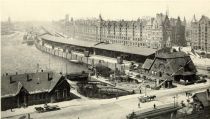
01. Row of buildings of the Free Port Warehousing Company
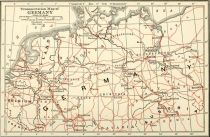
02. Transportation map of Germany
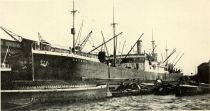
03. Hamburg freighter, being served by barges and lighters.
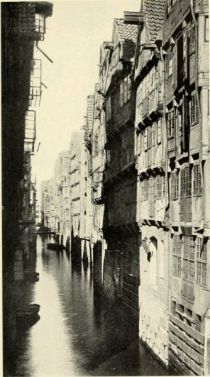
04. The Steekelhorn, one of Hamburg’s ancient canals
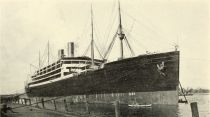
05. The „Kaiserin Auguste Victoria“.
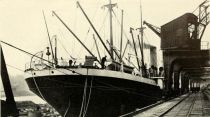
06. Hamburg freighter at a pier, discharging.
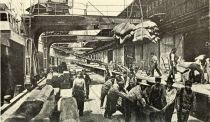
07. Pier cranes discharging cargo at Hamburg.
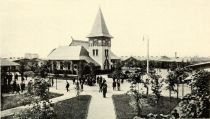
08. Church in the emigrant village at Hamburg.
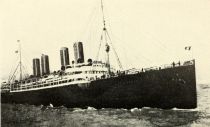
09. The „Deutschland“
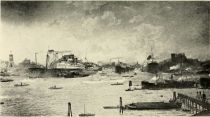
10. View looking into the main basin of the Hamburg-American Line.
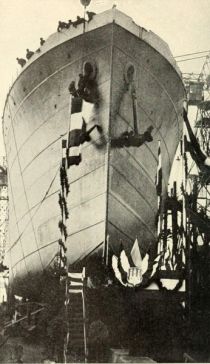
11. Launching of the „Fürst Bülow“.
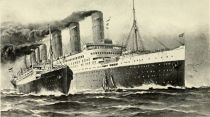
12. The „Imperator,“ the Hamburg-American’s new monster liner.